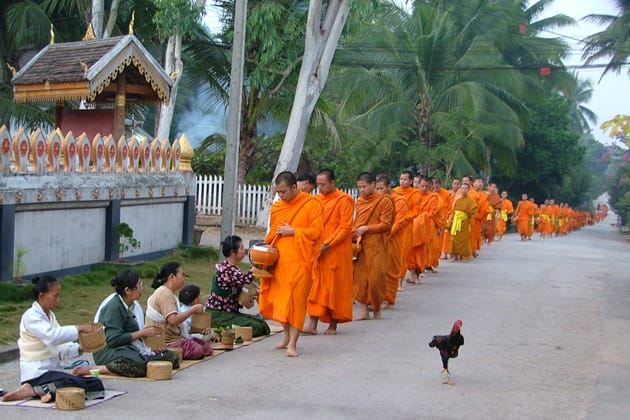Anchored at the junction of the Mekong and Nam Khan rivers, the former royal capital of Lane Xang is now a UNESCO World Heritage Site. It is home to a spell-binding array of gilded temples, weathered French colonial façades and art deco shophouses. In the 18th century there were more than 65 Wats in the city. Yet for all its magnificent temples and absorbing atmosphere this royal ‘city’ is now becoming an ersatz ‘tourist’ village. The entire historical centre appears to resemble one giant ’boutique’ hotel/coffee shop and few buildings are now used for anything except to service tourists.
With rents and costs spiralling the local Laos population are now disappearing from the centre of Luang Prabang and even the scores of monks who used to leave the monasteries every morning to collect alms from the town’s residents have been rumoured to be struggling to sustain themselves. One solution to this has been several shops selling extortionately priced, ready-made bags of food as ‘monk’s offerings’ at so that the snap-happy tourists can get the requisite photo of a saffron-clad monk walking in the mist.

Another factor lurking in the background are the Chinese, who seem keen to pour in money to help develop Luang Prabang, with a huge airport and urban developments being mooted. There’s no doubt that Luang Prabang is undergoing massive changes – the struggle will be to keep at least some of the original atmosphere and develop a sustainable future. The famous Pak Ou Caves and the Kouang Si Falls are located near the town.
Getting there
Flying is still the easiest option with daily connections from Vientiane, plus flights from Bangkok and Chiang Mai to Luang Prabang International Airport (LPQ).There is a standard US$2 charge for a tuk-tuk ride from the airport to the centre.
Kiew Lot Sai Nuan
(northern bus station), located on the northeast side of Sisavangvong Bridge, for traffic to and from the north; and Naluang (southern bus station) for traffic to and from the south. Occasionally buses will pass through the opposite station to what you would expect, so be sure to double-check. The standard tuk-tuk fare to/from either bus station is 15,000 kip. If there are only a few passengers, it’s late at night or you are travelling to/from an out-of-town hotel, expect to pay 20,000 kip. These prices tend to fluctuate with the international cost of petroleum. Another option is to travel by river: a firm favourite is the two-day trip between Luang Prabang and Houei Xai (close to the Thai border), via Pak Beng . Less frequent are the boats to Muang Ngoi and Nong Khiaw, via Muang Khua.






